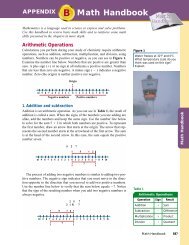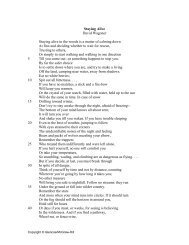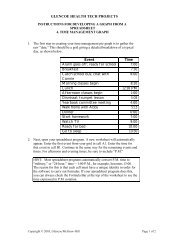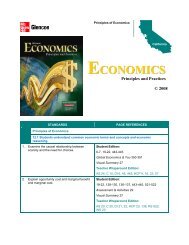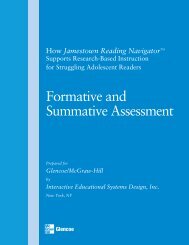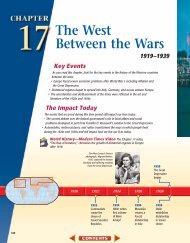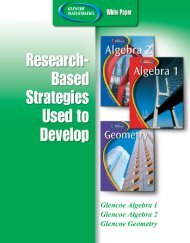Vocabulary - Research
Vocabulary - Research
Vocabulary - Research
Create successful ePaper yourself
Turn your PDF publications into a flip-book with our unique Google optimized e-Paper software.
instructional<br />
recommendations<br />
− Along similar lines, Baumann et al. (2003) identified one possible objective for vocabulary instructional<br />
programs as being to “Help students to develop an appreciation for words and to experience<br />
enjoyment and satisfaction in their use” (p. 778). Potential ways of doing this included<br />
the following:<br />
“Set a positive model. Demonstrate how word play can be interesting and enjoyable by<br />
expressing the value in possessing a versatile vocabulary and by demonstrating how word<br />
learning can be interesting and fun” (p. 778).<br />
“Have fun with words. Play word games linked to content topics and ones that may be done<br />
purely for entertainment and enjoyment” (p. 778).<br />
• Contextual analysis. According to Baumann and colleagues, “[R]esearch on teaching the process of contextual<br />
analysis as a transferable and generalizable skill is somewhat limited and at times equivocal (cf.<br />
Askov & Kamm, 1976; Hafner, 1965). However, experiments by Buikema and Graves (1993), Jenkins<br />
et al. (1989), Patberg et al. (1984), and Sternberg (1987) provide some evidence that instruction in contextual<br />
analysis may enable students to infer the meanings of words that have not been taught directly”<br />
(p. 772). Baumann et al. concluded: “<strong>Research</strong> on teaching contextual analysis as a transferable and<br />
generalizable strategy for word learning suggests that instruction does facilitate students’ ability to infer<br />
word meanings from surrounding context, although the relative efficacy of instruction in specific context<br />
clues versus simple practice in inferring meanings from context remains in question” (p. 774).<br />
• Morphemic analysis. Another general strategy that has been identified for vocabulary instruction is<br />
training students in morphemic analysis, which is described as “a word identification strategy in which<br />
the meanings of words can be determined or inferred by examining their meaningful parts,” including<br />
root words, prefixes, and suffixes (Baumann et al., 2003, p. 773). In their review of research, Baumann<br />
and colleagues (2003) determined, “Although several studies suggest that instruction in morphological<br />
elements may not be fruitful (e.g., Freyd & Baron, 1982; Otterman, 1955), other, perhaps more methodologically<br />
and pedagogically sound, experiments suggest that such training may be effective. Specifically,<br />
it appears as though elementary and middle grade students can be taught specific morphemic elements<br />
(e.g., Graves & Hammond, 1980) and that they are able to spontaneously generalize (infer) the meaning<br />
of one word from a morphologically similar derivative (Wysocki & Jenkins, 1987). . . . There is some<br />
indication that students can be taught specific morphemes (e.g., prefixes) that may enable them to unlock<br />
the meanings of unknown words containing these elements; also, there is some evidence that teaching<br />
students the meanings of unfamiliar words enables them to infer the meanings of morphologically related<br />
words” (p. 774).<br />
• Targeting of appropriate vocabulary words. Several researchers have raised issues related to which specific<br />
words should be selected for direct vocabulary instruction.<br />
− Blachowicz and Fisher (2000) raised the concern that “the words chosen for instruction in commercial<br />
anthologies might be ones that many students already know” (p. 509, citing Ryder &<br />
Graves, 1994; Stallman et al., 1990).<br />
J a m e s t o w n R e a d i n g N a v i g a t o r<br />
− Beck et al. (2002) identified “three things to keep in mind” in “evaluating words as possible<br />
candidates for instruction”: “How generally useful is the word? . . . How does the word relate to<br />
other words, to ideas that students know or have been learning? . . . What does the word bring<br />
to the text or situation?” (p. 29).<br />
− Beck and colleagues outlined a multitier system for classifying potential vocabulary words: “The<br />
first tier consists of the most basic words—clock, baby, happy, walk, and so on. Words in this<br />
tier rarely require instructional attention to their meanings in school. The third tier is made up of<br />
words whose frequency of use is quite low and often limited to specific domains. . . . The second<br />
tier contains words that are of high frequency for mature language users and are found across a<br />
variety of domains. Examples include coincidence, absurd, industrious, and fortunate. Because<br />
of the large role they play in a language user’s repertoire, rich knowledge of words in the second<br />
tier can have a powerful impact on verbal functioning. Thus, instruction directed toward Tier<br />
Two words can be most productive” (p. 8). Beck et al.’s tier model was described as a “promising<br />
approach” by Kamil (2003, p. 11).




